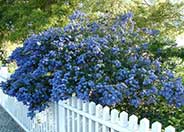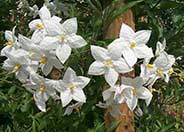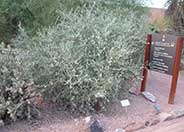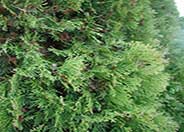
Common name:Concha California Lilac
Botanical name:Ceanothus 'Concha'
Concha is a lilac that grows 4'-8' in height and 12' wide. It has small narrow leaves with intense dark blue flower clusters in spring. It is tolerant of coastal and inland conditions.
Maintenance Tips
Ceanothus ‘Concha’ is a dramatic, evergreen native shrub that sends out dark blue flowers for about 4-6 weeks in the late spring. This is one of the hybrids of the native California Lilac and can reach 4-8' tall and up to 12' wide. It is a large, dense shrub that is drought tolerant once established and can take most soil conditions. To keep the maintenance as low as possible, give this plant the room it needs to reach its full mature size. The amount of space this plant requires is often underestimated, leading to poor pruning habits, like shearing, to control the size. If it is planted in a tight space, it is best to use the thinning method of pruning, cutting off the longest branches to the interior of the plant to allow sunlight in and to allow it to keep a natural shape. Over-watering during the hottest months of the year can lead to both pest and fungal issues. Water infrequently and deeply throughout the year and keep the soil around the base of the plant fairly dry to help discourage pest and disease problems.
Common name:Potato Vine
Botanical name:Solanum laxum
This twisting vine will grow 25' in length and has deciduous, glossy green leaves with blue and white flowers that are in constant bloom.

Common name:Catalina Cherry
Botanical name:Prunus ilicifolia ssp. lyonii
Catalina Cherry (Prunus ilicifolia ssp. Lyonii) is a fast-growing California native tree that is perfect for a water-wise garden. This tree can grow up to 40' tall and 30' wide, but it can be kept at a smaller size if it is managed by a licensed arborist. The tree is evergreen and is a great selection for gardens that are designed to attract wildlife. After blooming in spring, flowers are followed by a red fruit that is attractive to birds. To keep the maintenance as low as possible, it is best to plant this tree in a location that can absorb the fruit droppings, as the fruit tends to stain. Since it is a fast grower, it should be pruned frequently when it is young to encourage the desired shape. Once it reaches a mature size, leave the pruning to a licensed arborist. This tree should be planted at least four feet away from any hardscape areas, 10 feet from structures such as houses and buildings, and not near any powerlines. Shrubs and perennials should be planted about three feet away from this tree. It should be irrigated for about 45 minutes once a week when using most in-line drip irrigation systems.

Common name:Sunset Manzanita
Botanical name:Arctostaphylos 'Sunset'
This manzanita is a mounding shrub 4'-5' high and 4'-6' wide. It has coppery red new growth, then later turning bright green. It has pinkish-white flowers in winter to early spring.

Common name:Jojoba, Goat Nut
Botanical name:Simmondsia chinensis
This evergreen, extremely tough, durable shrub tolerates full sun, heat, and part shade. Feral goats eat the nuts, thus the common name, Goat Nut. Leaves are dark gray green and leathery. It has a slow to moderate growth rate, growing as large as 8'-10' tall, possibly larger. Jojoba is densely branched and can be pruned. Foliage is damaged in low 20's degrees F and killed below 15 degrees F. It is tolerant of adversity and drought.

Common name:Oriental Arborvitae
Botanical name:Platycladus occidentalis
This evergreen tree will grow 30'-60' tall and 10'-15' wide. It has small, scaled, light green leaves that turn brown in severe cold weather. This is a highly combustible plant.
Designer: Dave Buchanan Ocean Sage
Photographer: GardenSoft